
Jacopo della Quercia, also known as Jacopo di Pietro d'Agnolo di Guarnieri, was an Italian sculptor of the Renaissance, a contemporary of Brunelleschi, Ghiberti and Donatello. He is considered a precursor of Michelangelo.

Mino da Fiesole, also known as Mino di Giovanni, was an Italian Renaissance sculptor from Poppi, Tuscany. He is noted for his portrait busts.

The Piazza dei Miracoli, formally known as Piazza del Duomo, is a walled 8.87-hectare (21.9-acre) area located in Pisa, Tuscany, Italy, recognized as an important center of European medieval art and one of the finest architectural complexes in the world. Considered sacred by the Catholic Church, its owner, the square is dominated by four great religious edifices: the Pisa Cathedral, the Pisa Baptistery, the Campanile, and the Camposanto Monumentale. Partly paved and partly grassed, the Piazza dei Miracoli is also the site of the Ospedale Nuovo di Santo Spirito, which houses the Sinopias Museum and the Cathedral Museum.
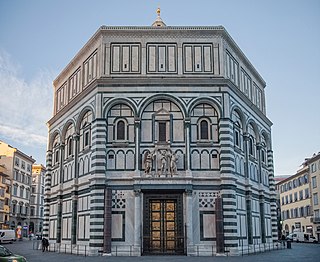
The Florence Baptistery, also known as the Baptistery of Saint John, is a religious building in Florence, Italy, and has the status of a minor basilica. The octagonal baptistery stands in both the Piazza del Duomo and the Piazza San Giovanni, across from Florence Cathedral and the Campanile di Giotto.

In Christian architecture the baptistery or baptistry is the separate centrally planned structure surrounding the baptismal font. The baptistery may be incorporated within the body of a church or cathedral, and provided with an altar as a chapel. In the early Church, the catechumens were instructed and the sacrament of baptism was administered in the baptistery.
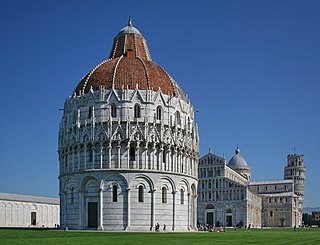
The Pisa Baptistery of St. John is a Roman Catholic ecclesiastical building in Pisa, Italy. Construction started in 1152 to replace an older baptistery, and when it was completed in 1363, it became the second building, in chronological order, in the Piazza dei Miracoli, near the Duomo di Pisa and the cathedral's free-standing campanile, the famous Leaning Tower of Pisa. The baptistery was designed by Diotisalvi, whose signature can be read on two pillars inside the building, with the date 1153.

Pisa Cathedral is a medieval Roman Catholic cathedral dedicated to the Assumption of the Virgin Mary, in the Piazza dei Miracoli in Pisa, Italy, the oldest of the three structures in the plaza followed by the Pisa Baptistry and the Campanile known as the Leaning Tower of Pisa. The cathedral is a notable example of Romanesque architecture, in particular the style known as Pisan Romanesque. Consecrated in 1118, it is the seat of the Archbishop of Pisa. Construction began in 1063 and was completed in 1092. Additional enlargements and a new facade were built in the 12th century and the roof was replaced after damage from a fire in 1595.
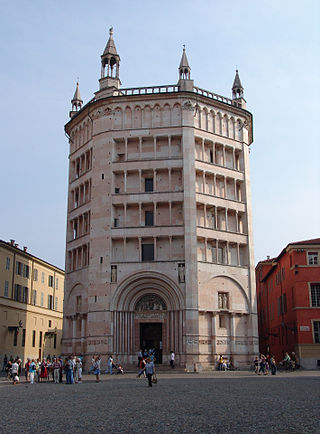
The Baptistery of Parma is a religious edifice in Parma, northern Italy. Architecturally, the baptistery of Parma Cathedral marks a transition between the Romanesque and Gothic styles, and it is considered to be among the most important Medieval monuments in Europe.
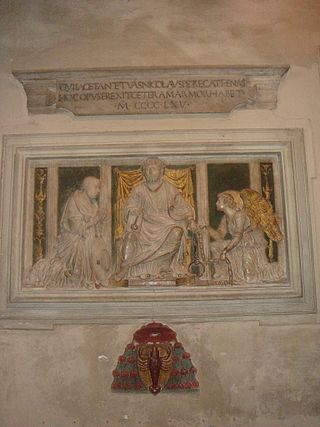
Andrea di Cristoforo Bregno (1418–1506) was an Italian Renaissance sculptor and architect of the Early Renaissance who worked in Rome from the 1460s and died just as the High Renaissance was getting under way.

Sant'Ambrogio is a Roman Catholic church in Florence, region of Tuscany, Italy. It is named in honour of St Ambrose.

Prato Cathedral, or Cathedral of Saint Stephen, is a Roman Catholic cathedral in Prato, Tuscany, Central Italy, from 1954 the seat of the Bishop of Prato, having been previously, from 1653, a cathedral in the Diocese of Pistoia and Prato. It is dedicated to Saint Stephen, the first Christian martyr.

The Cremona Baptistery is a religious edifice in Cremona, northern Italy. It is annexed to the city's Cathedral.

Andrea Ferrucci (1465–1526), also known as Andrea di Piero Ferruzzi and as Andrea da Fiesole, was an Italian sculptor who was born in Fiesole, Tuscany, in 1465. He was a first cousin once removed of the artist Francesco di Simone Ferrucci (1437–1493), under whom he studied.

Fiesole Cathedral, officially the Cathedral of Saint Romulus of Fiesole, is a Roman Catholic cathedral in Fiesole, Tuscany, central Italy. It is the seat of the Bishop of Fiesole and is dedicated to Saint Romulus.

The Battistero di San Giovanni is a religious building in Siena, Italy. It is in the square with the same name, near the final spans of the choir of the city's cathedral.

Volterra Cathedral is a Roman Catholic cathedral in Volterra, Italy, dedicated to the Assumption of the Virgin Mary. It is the seat of the bishop of Volterra.
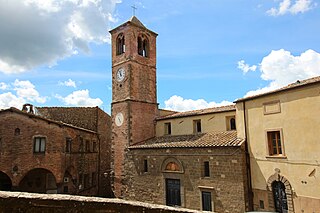
San Biagio is a romanesque-gothic style Roman Catholic church. It was erected during the 14th century in the town of Montecatini Val di Cecina, province of Pisa, in the region of Tuscany, Italy.

The San Giovanni in Corte Baptistery, also known as the Baptistery of San Giovanni di Rotondo, is a former Roman Catholic building in Pistoia, region of Tuscany, Italy. The octagonal baptistery stands at a slight angle across a small piazza from the Duomo of Pistoia in the center of town. It is presently used for cultural events.
The Collegiate Church of St. John the Baptist is a church in Chianciano Terme, Province of Siena, Italy.

San Giovanni Battista is a Gothic and Romanesque style, Roman Catholic church located in Piazza San Giovanni in the historic center of Gubbio, Umbria, in Italy.




















